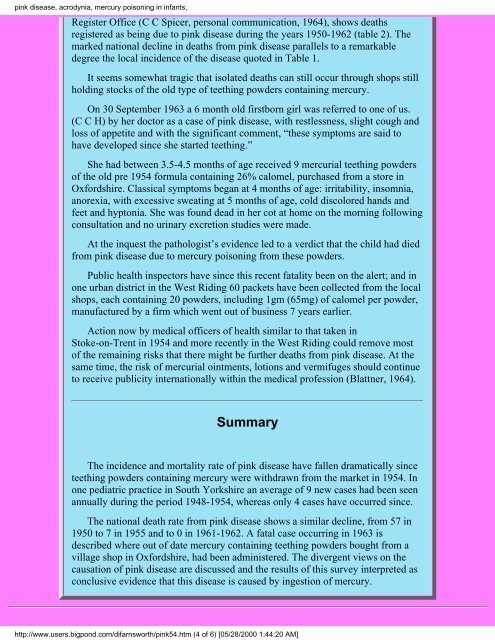Create successful ePaper yourself
Turn your PDF publications into a flip-book with our unique Google optimized e-Paper software.
pink disease, acrodynia, mercury poisoning in infants,Register Office (C C Spicer, personal communication, 1964), shows deathsregistered as being due to pink disease during the years 1950-1962 (table 2). Themarked national decline in deaths from pink disease parallels to a remarkabledegree the local incidence of the disease quoted in Table 1.It seems somewhat tragic that isolated deaths can still occur through shops stillholding stocks of the old type of teething powders containing mercury.On 30 September 1963 a 6 month old firstborn girl was referred to one of us.(C C H) by her doctor as a case of pink disease, with restlessness, slight cough andloss of appetite and with the significant comment, “these symptoms are said tohave developed since she started teething.”She had between 3.5-4.5 months of age received 9 mercurial teething powdersof the old pre 1954 formula containing 26% calomel, purchased from a store inOxfordshire. Classical symptoms began at 4 months of age: irritability, insomnia,anorexia, with excessive sweating at 5 months of age, cold discolored hands andfeet and hyptonia. She was found dead in her cot at home on the morning followingconsultation and no urinary excretion studies were made.At the inquest the pathologist’s evidence led to a verdict that the child had diedfrom pink disease due to mercury poisoning from these powders.Public health inspectors have since this recent fatality been on the alert; and inone urban district in the West Riding 60 packets have been collected from the localshops, each containing 20 powders, including 1gm (65mg) of calomel per powder,manufactured by a firm which went out of business 7 years earlier.Action now by medical officers of health similar to that taken inStoke-on-Trent in 1954 and more recently in the West Riding could remove mostof the remaining risks that there might be further deaths from pink disease. At thesame time, the risk of mercurial ointments, lotions and vermifuges should continueto receive publicity internationally within the medical profession (Blattner, 1964).SummaryThe incidence and mortality rate of pink disease have fallen dramatically sinceteething powders containing mercury were withdrawn from the market in 1954. Inone pediatric practice in South Yorkshire an average of 9 new cases had been seenannually during the period 1948-1954, whereas only 4 cases have occurred since.The national death rate from pink disease shows a similar decline, from 57 in1950 to 7 in 1955 and to 0 in 1961-1962. A fatal case occurring in 1963 isdescribed where out of date mercury containing teething powders bought from avillage shop in Oxfordshire, had been administered. The divergent views on thecausation of pink disease are discussed and the results of this survey interpreted asconclusive evidence that this disease is caused by ingestion of mercury.http://www.users.bigpond.com/difarnsworth/pink54.htm (4 of 6) [05/28/2000 1:44:20 AM]


